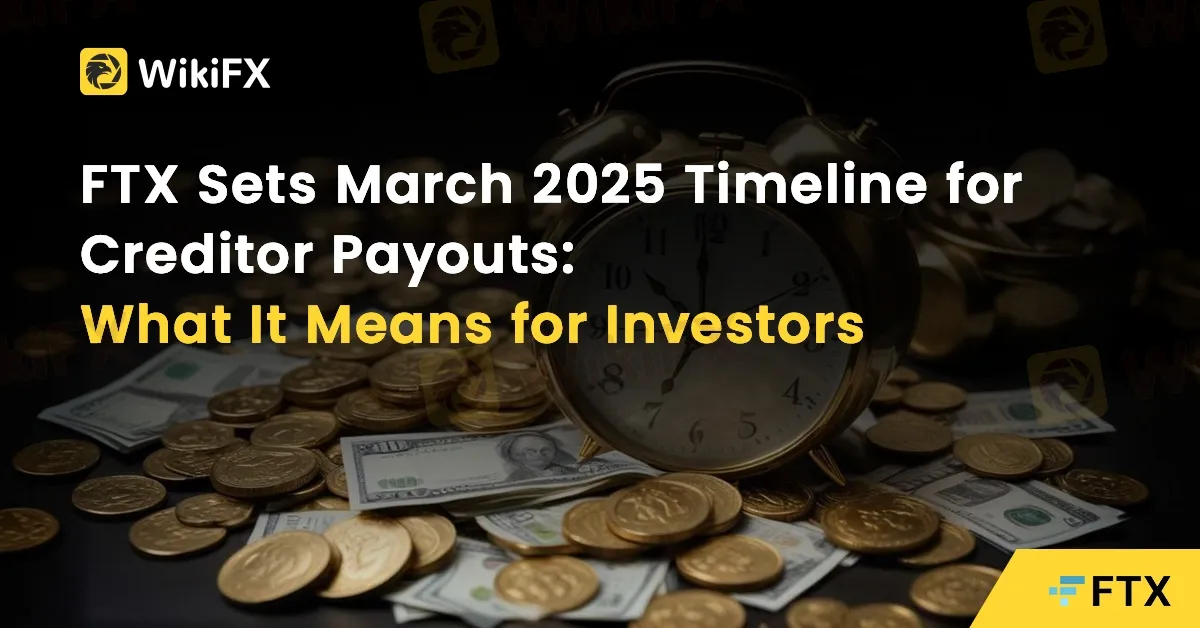简体中文
繁體中文
English
Pусский
日本語
ภาษาไทย
Tiếng Việt
Bahasa Indonesia
Español
हिन्दी
Filippiiniläinen
Français
Deutsch
Português
Türkçe
한국어
العربية
FTX Sets March 2025 Timeline for Creditor Payouts: What It Means for Investors
Abstract:The FTX bankruptcy estate has outlined a timeline for reimbursing creditors and customers, with initial payouts scheduled to begin in March 2025.

The FTX bankruptcy estate has outlined a timeline for reimbursing creditors and customers, with initial payouts scheduled to begin in March 2025. The collapsed cryptocurrency exchange is working to finalise arrangements with distribution agents by December 2024, ensuring the smooth management of the payout process through a dedicated customer portal.
Interim CEO John J. Ray III emphasised the estates commitment to expediting the reimbursement process while maximising recoveries. He stated that efforts are fully underway to reach agreements with distribution agents and return proceeds to affected creditors and customers.
Under the approved reimbursement plan, 98% of creditors are expected to receive at least 118% of their claim value in cash. A significant portion of the creditors, particularly those in the “dotcom customer entitlement claims” category, supported the plan, with 94% voting in favour. This group alone accounts for approximately $6.83 billion in claims.

In October 2024, a U.S. judge approved the reorganisation plan, with Judge Dorsey describing it as a “model case” for handling complex Chapter 11 bankruptcy proceedings. However, some creditors criticised the decision to calculate payouts based on digital asset prices at the time of the bankruptcy petition. For instance, Bitcoin was valued at $16,000 during the petition filing but has since surged to nearly $99,000.
Despite these concerns, legal representatives pointed out that FTX lacked the cryptocurrency reserves required for in-kind distributions. David Adler, a lawyer for some creditors, acknowledged the limitations, noting that cash reimbursements were the only viable option.
Beyond its reimbursement efforts, the FTX bankruptcy estate has been aggressively pursuing legal action against parties implicated in the platform's collapse. Lawsuits have been filed against various exchanges and individuals, including a $50 million claim against KuCoin, an $11 million suit against Crypto.com, and a $100 million case involving Anthony Scaramucci and SkyBridge Capital.
Additionally, Binance and its founder Changpeng Zhao are facing a $1.8 billion lawsuit. The FTX estate alleges that Binance received $1.76 billion in fraudulent transfers prior to FTX's downfall in 2022. These lawsuits aim to recover significant funds to support the estates overall recovery efforts.
While discussions of an “FTX 2.0” platform reboot were initially explored, the idea was ultimately shelved due to a lack of investor interest. The collapse of investor confidence made it impossible to secure the necessary capital for relaunching the exchange.
The saga of FTXs downfall also culminated in the criminal conviction of its former CEO, Sam Bankman-Fried. In November 2023, he was found guilty of fraud and sentenced to 25 years in prison. This development marked a dramatic conclusion to one of the most high-profile failures in the cryptocurrency industry.

Disclaimer:
The views in this article only represent the author's personal views, and do not constitute investment advice on this platform. This platform does not guarantee the accuracy, completeness and timeliness of the information in the article, and will not be liable for any loss caused by the use of or reliance on the information in the article.
Read more

Why More People Are Trading Online Today?
Discover why online trading is booming with tech, AI, and a push for financial freedom. From stocks to crypto, it’s a thrilling hustle for all.

SEC Ends Crypto.com Probe, No Action Taken by Regulator
The SEC has closed its investigation into Crypto.com with no action taken. Crypto.com celebrates regulatory clarity and renewed momentum for the crypto industry.

Interactive Brokers Expands Crypto Trading with Solana, XRP, Cardano, and Dogecoin
Interactive Brokers adds Solana, XRP, Cardano, and Dogecoin to its platform, enabling U.S. and U.K. clients to trade crypto 24/7 with low fees.

Bank Central Asia Addresses Cryptocurrency Scam Claims
Bank Central Asia responds to a cryptocurrency scam using its accounts, targeting investors via social media. Learn about the scam and BCA’s stance.
WikiFX Broker
Latest News
How Crypto Trading Transforms FX and CFD Brokerage Industry
UK would not hesitate to retaliate against US tariffs - No 10 sources
FCA Warns Against 10 Unlicensed or Clone Firms
CySEC Warns Against 14 Unlicensed Investment Websites
Top Currency Pairs to Watch for Profit This Week - March 31, 2025
Will natural disasters have an impact on the forex market?
Philippines Deports 29 Indonesians Linked to Online Scam Syndicate in Manila
Navigating the Intersection of Forex Markets, AI Technology, and Fintech
Exposed: Deceptive World of Fake Trading Gurus – Don’t Get Fooled!
AI-Powered Strategies to Improve Profits in Forex Trading
Currency Calculator







